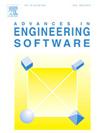Thermomechanical free vibration buckling of FG graphene-reinforced doubly-curved sandwich shells
IF 5.7
2区 工程技术
Q2 COMPUTER SCIENCE, INTERDISCIPLINARY APPLICATIONS
引用次数: 0
Abstract
This study explores the thermomechanical free vibration and buckling behavior of doubly-curved sandwich shell structures with a core of FG graphene-reinforced foam and metal or ceramic face layers. Using Hamilton's principle and a Navier-type solution method, the governing equations and boundary conditions for simply supported, functionally graded doubly-curved shells are derived. The numerical results are validated through comparison with existing literature. The analysis focuses on the effects of the material grading index, foam void ratio, graphene volume fraction, side-to-thickness ratio, and temperature variations. Notably, it was observed that as R1 increases from α to 10α, the buckling temperature significantly decreases, highlighting a reduction in thermal stability with increasing radii or inverse correlation between R1 and R2. These findings reveal unexpected thermal instability trends that could influence future design considerations for high-temperature applications. This study provides novel insights into the thermomechanical behavior of advanced sandwich structures, offering valuable contributions to the field in light of evolving technological needs.
FG石墨烯增强双弯曲夹层壳的热力学自由振动屈曲
本研究探讨了以FG石墨烯增强泡沫为核心,表面为金属或陶瓷层的双弯曲夹层壳结构的热力学自由振动和屈曲行为。利用Hamilton原理和navier型解法,导出了简支功能梯度双弯曲壳的控制方程和边界条件。通过与已有文献的比较,验证了数值计算结果。重点分析了材料分级指数、泡沫空隙比、石墨烯体积分数、边厚比和温度变化的影响。值得注意的是,当R1从α增加到10α时,屈曲温度显著降低,表明热稳定性随R1和R2的半径增加或负相关而降低。这些发现揭示了意想不到的热不稳定性趋势,可能会影响未来高温应用的设计考虑。这项研究为先进夹层结构的热力学行为提供了新的见解,为不断发展的技术需求提供了有价值的贡献。
本文章由计算机程序翻译,如有差异,请以英文原文为准。
求助全文
约1分钟内获得全文
求助全文
来源期刊

Advances in Engineering Software
工程技术-计算机:跨学科应用
CiteScore
7.70
自引率
4.20%
发文量
169
审稿时长
37 days
期刊介绍:
The objective of this journal is to communicate recent and projected advances in computer-based engineering techniques. The fields covered include mechanical, aerospace, civil and environmental engineering, with an emphasis on research and development leading to practical problem-solving.
The scope of the journal includes:
• Innovative computational strategies and numerical algorithms for large-scale engineering problems
• Analysis and simulation techniques and systems
• Model and mesh generation
• Control of the accuracy, stability and efficiency of computational process
• Exploitation of new computing environments (eg distributed hetergeneous and collaborative computing)
• Advanced visualization techniques, virtual environments and prototyping
• Applications of AI, knowledge-based systems, computational intelligence, including fuzzy logic, neural networks and evolutionary computations
• Application of object-oriented technology to engineering problems
• Intelligent human computer interfaces
• Design automation, multidisciplinary design and optimization
• CAD, CAE and integrated process and product development systems
• Quality and reliability.
 求助内容:
求助内容: 应助结果提醒方式:
应助结果提醒方式:


